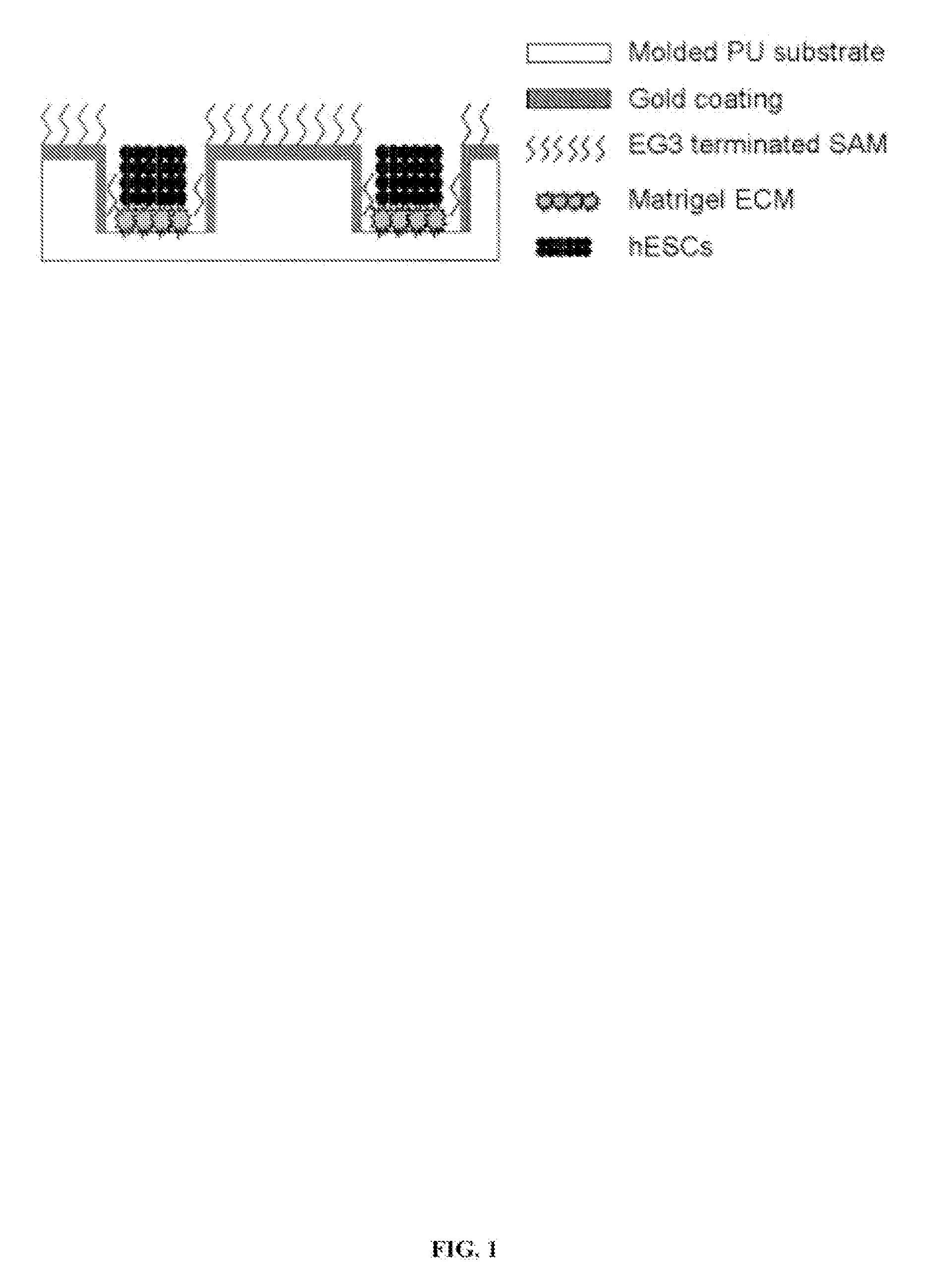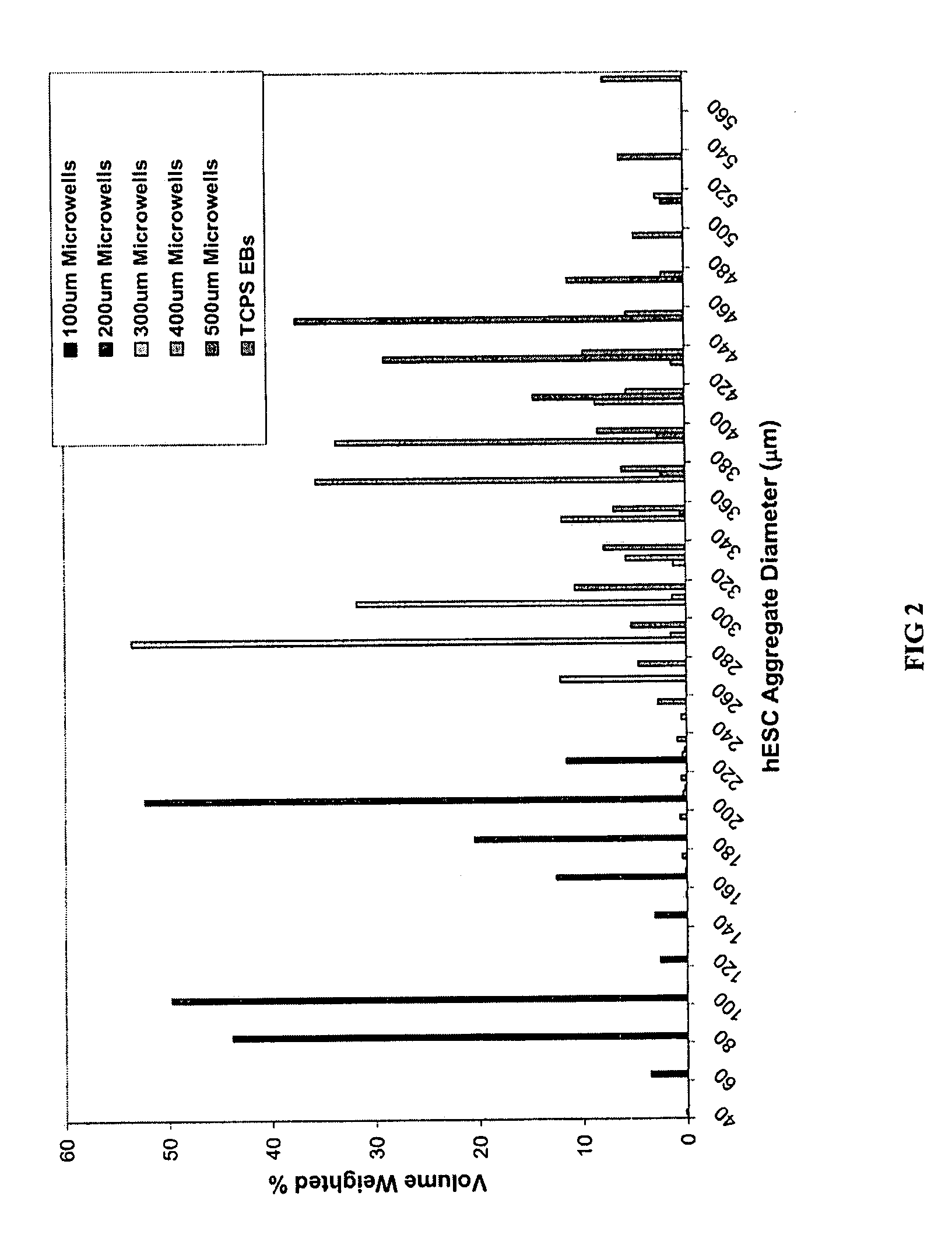Method for culturing stem cells
a stem cell and culturing technology, applied in the field of culturing stem cells, can solve the problems of inconvenient long-term hesc culture, lack of simple methods for producing ebs of consistent and desired size, and lack of 2-d sam monolayers, etc., to achieve the effect of ensuring the cell differentiation profile of ebs and facilitating the control of the cell differentiation profil
- Summary
- Abstract
- Description
- Claims
- Application Information
AI Technical Summary
Benefits of technology
Problems solved by technology
Method used
Image
Examples
example 1
Microwells for hESCs Culture and Embryoid Body Generation
[0027] Reference is made to FIG. 1. Microscope slides having formed thereupon a homogeneous distribution of wells of identical size and shape were constructed in three steps using a polydimethylsiloxane (PDMS) stamp to shape a surface of a UV-crosslinkable polyurethane polymer substrate. First, silicon masters, each having desired microwell patterns formed into a surface thereof, were prepared using photolithography and plasma etching techniques similar to those described by Chen et.al. [22], incorporated herein by reference as if set forth in its entirety. The surfaces were passivated by fluorination with (tridecafluoro-1,1,2,2,-tetrahydrooctyl)-1trichlorosilane vapor. Second, a mixture of PDMS elastomer pre-polymer with curing agent (10:1) (Sylgard 184 Silicon Elastomer; Dow Corning, Midland, Mich.) was poured over silicon masters to form PDMS stamps. The mixture was degassed under vacuum and incubated overnight at 70° C. t...
example 2
Directed Differentiation of hESCs from Microwell Cultures
[0046] hESCs were cultured either in microwells having depths of 50 μm-120 μm and lateral dimensions of 50 μm-500 μm or in TCPS plates as described above. Briefly, samples were incubated for 30 minutes at 37° C. to allow hESCs to settle into the microwells before adding 1.5 ml / well CMF+ to the wells of a 6-well plate. The medium was changed daily thereafter and the cells typically reached confluence within a week. TCPS EBs and microwell-derived EBs were then formed as described above.
[0047] Keratinocytes differentiation was achieved by initially forming EBs from microwell-derived hESC aggregates as described above. EBs were grown in suspension for fourteen days in UMF-medium and then attached to gelatin-coated plates in Defined Keratinocyte Serum Free Medium (DSFM) (Invitrogen; Carlsbad, Calif.). Cells were cultured 2-3 weeks prior to analysis by immunocytochemistry and flow cytometry, as described for undifferentiated cells...
example 3
Microwells for hESCs Culture and Cryopreservation
[0051] hESCs were cultured in microwells having dimensions of 50 μm deep with 50 μm-400 μm lateral dimensions as described above. Briefly, samples were incubated for 30 minutes at 37° C. to allow hESCs to settle into the microwells before adding 1.5 ml / well CMF+ to the wells of a 6-well plate. The medium was changed daily thereafter and the cells typically reached confluence within a week. Alternatively, hESCs were cultured in TCPS dishes, as described above.
[0052] After 7 days of culture, the hESCs in microwells, suspensions and TCPS plates were place in freezers at −80° C. for up to 4 weeks. Following cryopreservation, cells frozen in suspension were thawed by immersion of the cryovial in a 37° C. waterbath with agitation. Cells were immediately diluted in 10 ml CMF (i.e. hESC medium conditioned on mouse embryonic fibroblasts with bFGF) and centrifuged. hESCs were then diluted in 2 ml CMF and plated to 1 well of a 6-well plated pr...
PUM
| Property | Measurement | Unit |
|---|---|---|
| depth | aaaaa | aaaaa |
| depth | aaaaa | aaaaa |
| depth | aaaaa | aaaaa |
Abstract
Description
Claims
Application Information
 Login to View More
Login to View More - R&D
- Intellectual Property
- Life Sciences
- Materials
- Tech Scout
- Unparalleled Data Quality
- Higher Quality Content
- 60% Fewer Hallucinations
Browse by: Latest US Patents, China's latest patents, Technical Efficacy Thesaurus, Application Domain, Technology Topic, Popular Technical Reports.
© 2025 PatSnap. All rights reserved.Legal|Privacy policy|Modern Slavery Act Transparency Statement|Sitemap|About US| Contact US: help@patsnap.com



